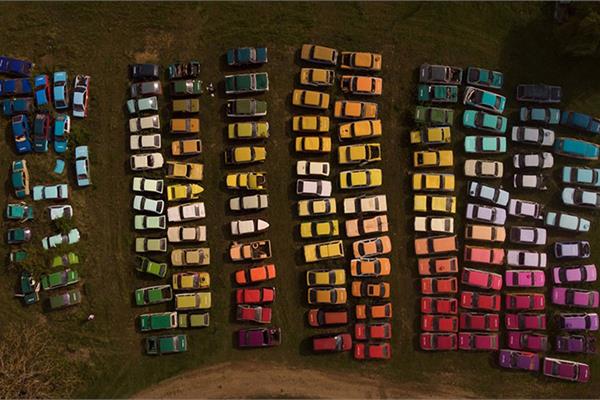
Solara is site-specific art installation by French painter Zoer, which features 144 automotive models recovered by one of largest scrapyard in France. With this project, the artist aims at creating an industrial heritage by saving automobile wreckage, while cleaning up metal-polluted soils.
Zoer's project links the heart of painting - the colour - to the automobile wreck, by defining a palette on 144 automobile models.
The artwork title is a reference to a car model produced until 1981, the latest car of Anglo-French car manufacturer Talbot: The Talbot Solara. This model is among the 144 painted cars that make up the colour chart. The title has been specifically chosen among all the industrial names because it etymologically refers to the solarization phenomenon, a natural process of colour alteration after a long exposure to the sunlight. To respect this phenomenon, Zoer's intervention focuses mainly on the hoods, roofs, and trunks of the cars.
The layout of these cars corresponds to the way in which the scrapyard owner for 50 years has arranged them throughout his life. The classification by model, imperfectly aligned, has given direction to the implementation of the colours. The rows guided the gradual application of hues to release tensions, synchronized by saturation and intensity in a rectangular set. Each vehicle appears as a component of an overall composition, a pixel with its own colour and brightness among all the elements of an image. The subjectivity of the colour is expressed by the application of hexadecimal codes, possible translations of each colour in the RGB system.
Heritage and ecology: the aim of the project
To preserve the memory of these car wrecks, the artist has created a colour chart in which the RGB reference is combined with the collective imagination by renaming each shade used with the name of the car model on which it was applied, for example Kadette blue 31.0f405c or W110 Mercedes Honey.e6c359. This way, each colour carries with it the history of the object, its use, and its personality.
By associating the individual aspect of the object with the infinity of possibilities offered by the RGB system, all these automobiles also reflect the collective impact of consumer objects, underlining the consequent global footprint issue.
In fact, through this installation, the artist wants to underline the necessity to save automobile wreckage not only as industrial heritage but also to avoid soil pollution. To tackle both issues, Zoer launched a successful crowdfunding campaign to buy hyperaccumulating plants for phytoremediation of the French scrapyard and bring these wrecks to the museum.
Symbolically, the artist would like that for each car saved from complete destruction and showcased in a museum or private collection, an agricultural plot of hyperaccumulating plants equivalent to the car's size is planted.
From harvesting these plants, metal slats can be recovered and reused to create ceramic paints.